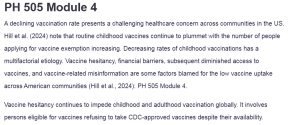PH 505 Module 4
A declining vaccination rate presents a challenging healthcare concern across communities in the US. Hill et al. (2024) note that routine childhood vaccines continue to plummet with the number of people applying for vaccine exemption increasing. Decreasing rates of childhood vaccinations has a multifactorial etiology. Vaccine hesitancy, financial barriers, subsequent diminished access to vaccines, and vaccine-related misinformation are some factors blamed for the low vaccine uptake across American communities (Hill et al., 2024): PH 505 Module 4.
Vaccine hesitancy continues to impede childhood and adulthood vaccination globally. It involves persons eligible for vaccines refusing to take CDC-approved vaccines despite their availability. Increases in vaccine hesitancy remain rampant in ethnic minority communities and have been attributed to sociocultural factors and misconceptions about vaccines.
Vaccine-related misconception is also a concern in the US. With the rise of anti-vaxxers being apparent, the perpetuation of misinformation related to safety issues of available vaccines. Social media platforms have particularly been used to spread misinformation about vaccines, compounding the problem of poor childhood vaccinations (Cardoso Pinto et al., 2023).
Children are particularly vulnerable to the effects of infectious illnesses. This is because they have more contact with others. Additionally, their immune systems are still developing, lowering their ability to fight infectious illnesses. Notwithstanding, the decision on whether to take vaccines often remains the responsibility of the parents.
Epidemiological factors such as low health literacy, poor access to healthcare, sociocultural factors such as the definition of illnesses and race, and environmental factors such as living spaces influence vaccination uptake rates across communities and the health impacts of infectious illnesses. Poor health literacy impedes individuals’ ability to understand the significance of vaccines and their impact on social wellness. Addressing poor health literacy may, therefore, enhance the uptake of available childhood vaccines across communities (Cardoso Pinto et al., 2023).
References
Cardoso Pinto, A. M., Shariq, S., Ranasinghe, L., Sundar Budhathoki, S., Skirrow, H., Whittaker, E., & Seddon, J. A. (2023). Reasons for reductions in routine childhood immunisation uptake during the COVID-19 pandemic in low- and middle-income countries: A systematic review. PLOS Global Public Health, 3(1). https://doi.org/10.1371/journal.pgph.0001415
Hill, H. A., Yankee, D., Elam-Evans, L. D., Mu, Y., Chen, M., Peacock, G., & Singleton, J. (2024, September 26). Decline in vaccination coverage by age 24 months and vaccination inequities among children born in 2020 and 2021 -National Immunization Survey-child, United States, 2021–2023. Centers for Disease Control and Prevention. https://www.cdc.gov/mmwr/volumes/73/wr/mm7338a3.htm
ORDER A PLAGIARISM-FREE PAPER HERE
We’ll write everything from scratch
Question
1. Using health data (behavioral and environmental), discuss why the people in the target population have the health problem. So, what is the problem, who has it and why.
Epidemiological diagnosis – determine the health problems or other issues that affect the community’s quality of life. Include also the behavioral and environmental factors that must change in order to address these problems or issues. Behavioral factors include patterns of behavior that constitute lifestyles. In considering environmental factors, you should include the physical, social, political, and economic environments.

PH 505 Module 4

